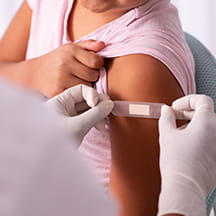The numbers are well-documented and paint a sobering portrait of the hunger problem in America.
According to U.S. Department of Agriculture (USDA) data, food insecurity affected one in eight households with children in 2021—more than 33 million people. The scope of the problem is even more widespread among single-parent and minority households.
For Kimberly Montez and her team, seeing the issue firsthand sparked change. “The desire to address food insecurity at our clinic started after frequently hearing devastating patient stories—families telling us they weren’t able to access food or children who hadn’t eaten and were very hungry,” says Montez, M.D., M.P.H., FAAP, associate director of integrating special populations at Maya Angelou Center for Health Equity and assistant pediatrics program director at Brenner Children’s Hospital in Winston-Salem, North Carolina.
Their efforts began with a pediatric resident advocacy project in 2013 that established a food pantry at the Brenner Children’s Downtown Health Plaza (DHP) clinic location in Winston-Salem. The program has expanded over the years to meet the needs of the community with a focus on striving beyond food security to achieving nutrition security—not only addressing the quantity of food provided but also its quality.
“Nutrition security is consistent and equitable access to healthy, safe and affordable foods that are essential to optimal health and well-being,” Montez says. “It is our aspiration as pediatricians.”
Community partnerships for food and nutrition security
The Brenner Children’s program has evolved over the years along guidelines set forth by several sources, including the American Academy of Pediatrics (AAP) and Food Research & Action Center (FRAC) pediatrician’s toolkit on screening and intervention around food insecurity—in fact, Montez is one of the work’s co-authors. Today, the hospital employs a multi-faceted approach to addressing food and nutrition insecurity through its local and national cooperatives.
“Many of these community partners and organizations have been addressing hunger and food insecurity for decades, so they really are the experts,” Montez says. “Given their expertise, we’ve spent a significant amount of time building relationships with each of these organizations.” Among them:
- Campus Kitchen. Wake Forest student-led program that repurposes food from area providers that otherwise would have gone to waste, including fresh produce.
- Second Harvest Food Bank. Low-cost source of nutritious food to stock clinic food pantries.
- Help Our People Eat (H.O.P.E.) of Winston-Salem. Community anti-hunger organization with an onsite farmer’s market.
- Brenner FIT. The hospital’s pediatric weight-loss program that helps design recipe-based food bags containing all the ingredients necessary for patient families to cook a healthy meal and conducts regular cooking classes at the DHP clinic.
- Delivery services. Brenner Children’s has partnered with Project DASH (DoorDash Acts for Sustainability and Hunger) to deliver meals to new mothers who had screened positive for food insecurity.
- Federal programs. Outpatient screening includes a check for eligibility in Special Supplemental Nutrition Program for Women, Infants, and Children (WIC) and SNAP (Supplemental Nutrition Assistance Program); referrals can be generated automatically through the hospital’s electronic medical record (EMR) system.
How to grow and sustain food and nutrition security
In addition to community and governmental partnerships, Montez says the strength of internal relationships is integral to a food insecurity program’s success. They include identifying an in-house champion to propagate the mission throughout the enterprise and “finding a friend in the IT department” to help link patient screening with the medical record systems. Perhaps most important is obtaining buy-in from leadership to pave the way for the program to not only be built but also maintained.
“Having a plan for sustainability is really important,” Montez says. “Engaging with your leadership—not just at a clinical level but also potentially at the institutional level—and having a plan with constant conversations about how this work will be supported beyond grant funding and philanthropy.



